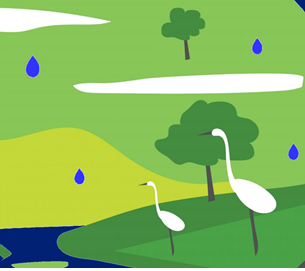India gets two more Ramsar Sites
- 03 Feb 2022
On 2nd February, 2022 a national level celebration of World Wetlands Day 2022 was held at Sultanpur National Park, a Ramsar site of Haryana.
- At the event, two new Ramsar sites (Wetlands of International Importance), were declared and "National Wetland Decadal Change Atlas” was also released.
- India now has a network of 49 Ramsar sites covering an area of 10,93,636 hectares, the highest in South Asia.

About the New Sites
Khijadiya Bird Sanctuary
- Khijadiya Bird Sanctuary is located in Jamnagar district of Gujarat.
- Khijadiya has become the fourth wetland of Gujarat to get the Ramsar tag. Nalsarovar Bird Sanctuary, Thol Wildlife Sanctuary and Wadhwana wetland are the other Ramsar sites in the state.
- The sanctuary is unique having both fresh water lakes, salt and freshwater marshlands.
- It is a coastal wetland with rich avifaunal diversity providing a safe habitat to endangered and vulnerable species.
- Khijadiya is part of the Central Asian Flyway (important migration routes of waterbirds, most of which extend from the northernmost breeding grounds in Siberia to the southernmost non-breeding wintering grounds in West Asia, India, the Maldives and the British Indian Ocean Territory).
- The site provides breeding, feeding and roosting grounds for a wide range of resident aquatic and also land-based birds. It provides habitat for over 310 bird species, including 125 waterbirds.
Bakhira Bird Sanctuary
- The Bakhira Bird Sanctuary is the largest natural flood plain wetland of India in Sant Kabir Nagar district of Eastern Uttar Pradesh.
- It is the 10th wetland of Uttar Pradesh to get the Ramsar tag.
- Bakhira Bird Sanctuary is a freshwater marsh protected under the Wildlife Protection Act (1972); an “eco-sensitive zone” extends up to a kilometre around its boundary.
- The wetland is internationally important for its birdlife as it supports over 80 species. It provides a wintering ground for over 25 species that migrate on the Central Asian Flyway. The Siberians birds travel across 5000 km to get to these wetlands at the time of winter.
- This wetland also supports 119 plant species and 45 species of fish.
About "National Wetland Decadal Change Atlas”
- It is prepared by the Space Applications Centre (SAC), Ahmedabad.
- It highlights the changes which have happened in Wetlands across the country in the past decade.
- The original Atlas was released by SAC in 2011 and has over the years been used extensively by all the State Governments also in their planning processes.
Some Findings
- Total wetland area estimated is 15.98 Mha, which is around 4.86 percent of the total geographic area of the country.
- In comparison to earlier wetland inventory of 2006-07, a total increase of 0.64 Mha area and 18810 wetland numbers obtained.
- Total 14823 new wetlands added with an area of 0.36 Mha and out of this more than 93% are inland wetlands.
- Total 1342 wetlands which were existing earlier and covering an area of 0.025 Mha has been disappeared in 2017-18.
- There is decrease in coastal natural wetlands which are mostly converted to coastal man-made category with major change goes to intertidal mud flat which is converted to Salt pans in Rann of Kachchh.
- There is increase in the mangroves area (3.8%; 18662 ha). Most of the intertidal mud flats are converted to mangroves.
- There is increase in coral reefs area 2784 ha (1.9%) which is mainly in Kachchh (1881 ha) and Andaman and Nicobar islands (892 ha).
- Overall country level decadal change in wetland numbers and area are of 8.86% and 4.18%, respectively.
| World Wetlands Day
|




